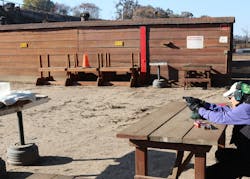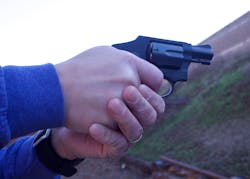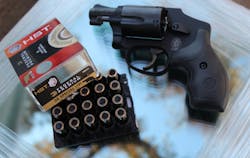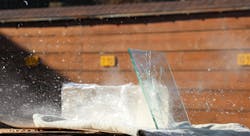Old School Is Still Cool
For this month’s Firearms Tactics column I tested the Smith & Wesson Model 442 and Federal 130 grain HST +P ammunition. At the end of this test, I believed that old school is still cool. What do I mean by that? J-Frame revolvers, which have been around since the 1950s, are still effective in the modern law enforcement officer’s toolbox.
Smith & Wesson J-Frames can be divided into three separate categories. There are extremely lightweight models like the 342PD Centennial, which weighs 10.8 ounces, and heavier models like the 19.5 ounce classic Model 36.Although J -Frames are available in several calibers, I have always preferred them in .38 Special. The heavier ones are more comfortable to shoot, which certainly makes sense. The lighter ones are easier to carry, which also makes sense. The .38 Special is a cartridge that can do anything, including operate at pressures that are reasonable for the size and design of the J-Frame.
Then there is a Goldilocks happy medium—the Model 442. The Model 442 is a variation of the Model 42 Centennial Airweight. It’s 14.7 ounces, holds the traditional 5 shots, handles +P rounds, and has a snag-free design.
A lightweight revolver is something every law enforcement officer should have. They are simple and reliable. Modern cartridges have made them very effective. The Model 442 is small and light enough for pocket carry and they naturally can fit anywhere, including in a BUG Pouch (bugpocket.com). I recommend stuffing a couple of Tuff Products QuickStrips (tuffproducts.com) in the BUG Pouch. In the pocket, the Sticky Holster MD-5 is the correct size (stickyholsters.com).
J-Frames are also fairly maintenance-free. In all the time I have been testing and shooting revolvers, I have never seen a J-Frame fail. To put this in perspective, the .38 Special is the easiest cartridge to reload in the entire spectrum of cartridges. I reload a lot of them. I run hundreds of rounds through my J-Frame. I shoot my revolvers a lot because I am more likely to carry one than any other gun.
The simplicity of the firearm
When my testing team got the Model 442 to the range, we started by shooting Federal American Eagle 130 grain FMJ rounds. This is a good practice round that mimics the Federal 130 grain HST JHP Micro cartridges designed for personal defense. For both cartridges, we were able to punch sub 1” groups at 5 yards.
One of the rules of concealed carry guns to which I adhere is its combat accuracy. As a rule, it is important to answer the question, “Can I make a 7-yard hostage shot with this gun?” That is, can the shooter confidently place a consistent group into a 4” target at 7 yards? The S&W Model 442 can do this easily.
Another rule is carrying enough reloads and being able to get back into the fight with the carry gun. Reloads with a J-Frame, or any revolver, are quicker than most people think. Check out a recent article focusing on a 5-step reloading sequence for the revolver at Officer.com/20994539.
There is no sighting in for this type of revolver. The front sights are integral and the rear sights are fixed. That is, both front and rear sights are manufactured into the barrel and frame, respectively. When we purchase this type of handgun, we have an expectation that Smith & Wesson has sighted the revolver competently at the factory. The sights cannot be drifted and changing the point of impact relative to the sights would take a gunsmith or a return to the manufacturer. The upside to not being able to drift the sights is the simplicity of owning this gun. No activity associated to using the gun will change its ability to accurately steer bullets at the target. It can take some seriously rough handling.
Now back to the range. Robert Marvulli, a member of our testing team, brought his S&W 340PD. It is similar to the Model 442, but handles .357 Magnum, which makes it the perfect hiking and camping gun.
The 340PD is a great carry-a-lot-use-a-little gun and it is one of the best BUG guns for LEOs ever. However, 11.8 ounces with .357 Magnum cartridges can be rough on the user for all-day shooting.
It was much easier to shoot the Model 442. The additional 2.9 ounces makes a big difference taming the recoil, while everything else feels the same. They use the same speed loaders and fit some of the same holsters, too. There are several ideal features of the 340PD, like a very bright front sight, but the Model 442 is about (MSRP) $600 cheaper.
My Model 442 came with synthetic grips that have molded texturing. The curved backstop and molded finger recesses give the shooter a consistent master grip. I have medium-sized hands and was able to keep my smallest finger on the front of the gun.I like a lot of clearance for speed loaders on the left side of a revolver. J-Frame cylinders don’t swing out enough for big speed loaders. Recessing more clearance into the gunstocks only helps a little. We use the billet aluminum 5 Star Speedloaders (5starfirearms.com), which are light and fast. They work better in J-Frames and they allow me to carry more rounds in less space.
The Model 442 has a lightweight alloy frame, but all parts that handle pressure are steel. The cylinder is carbon steel and the barrel is stainless steel. It has an “all business” matte black finish, which is consistent and very durable. How do I know about the durable finish? The S&W I carry all the time was built in the 1970s. I run piles of ammo through it, including the stuff from my lead 158 grain molds. I have two buckets full of 38 brass—approximately 7,000 rounds—and I use them to move lead from one end of a range to the other. My J-Frame has never failed.
The 442 is a double action only gun. The trigger runs smoothly, with only a little stacking in the middle of the cycle. It has a completely enclosed hammer, making it perfect for pocket carry.
The cylinder lockup was smooth, and even the +P loads we ran through it extracted smoothly.
A closer look at ammunition
The 130 grain HST is unique. Rather than having a bullet protrude from the brass normally, the bullets are completely recessed into the brass. Federal says that the deeply seated bullet precludes inconsistent powder burn rates. While eliminating inconsistent burn rates is a benefit, the fact that this cartridge is shorter has other advantages. The full speed loaders are shorter, making it easier to carry in the pocket. The shorter cartridges load much quicker in a J-Frame because it clears the stocks better.
There are several reasons why 130 grain is a good weight for pocket-sized revolvers. First, all lightweight guns like the Model 340PD have a warning inscription on the barrel that reads “NO LESS THAN 120 GR BULLET”. One reason for this is the fact that this prevents premature erosion in the titanium alloy cylinders. The Model 442 doesn’t have this restriction, but the 340PD does.We shot the HST round into bare gelatin and laminated glass. In bare gelatin, the 130 grain bullet plowed through just shy of 12”. The bullet opened about 150 percent. Considering the size of the bullet at rest and the full weight retention, this wasn’t bad. The bullet at rest had expanded into a large six-petal flower with full weight retention.
Shooting it through laminated glass, the first shot traveled only 3.5”. The core separated, but remained adjacent to the jacket. The HST bullet is a bonded bullet, meaning the manufacturer does something so they stay together. Subsequent shots easily demonstrated that the bonded core works and after barrier penetration was a little better.
The HST round had two other qualities that cannot be overlooked. It was accurate in a snub-nose gun. Most importantly, it didn’t flash as much as similar products.
The .38 HST round has a tendency to open quickly in gelatin, which is easily explained by a huge hollow cavity and pre-scored bullet. As a personal defense round, it will definitely generate interest amongst CCW users. For a law enforcement back up or EDC gun, the Model 442 is a great choice.
About the Author

Officer Lindsey Bertomen (ret.), Contributing Editor
Lindsey Bertomen is a retired police officer and retired military small arms trainer. He teaches criminal justice at Hartnell College in Salinas, California, where serves as a POST administrator and firearms instructor. He also teaches civilian firearms classes, enjoys fly fishing, martial arts, and mountain biking. His articles have appeared in print and online for over two decades.




